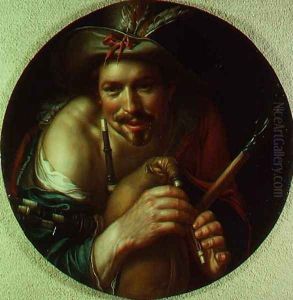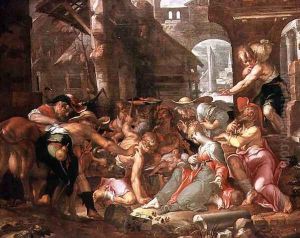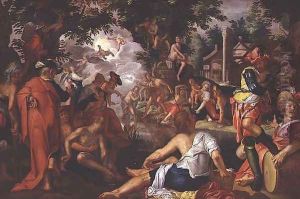Joachim Anthonisz Uytewael Paintings
Joachim Anthonisz Uytewael, sometimes also spelled as Joachim Anthonisz Wtewael or Uytewael, was a Dutch Mannerist painter and draughtsman, as well as a highly reputed engraver and glass painter. Born in 1566 in Utrecht, then part of the Holy Roman Empire, Uytewael was one of the leading figures in Dutch art during the late 16th and early 17th centuries, known for his intricate and often erotically charged mythological scenes.
Uytewael began his artistic training with his father, Anthonis Uytewael, who was a glass painter. He continued his education by traveling to France and Italy, where he was exposed to the works of the Italian Renaissance and Mannerist artists. This experience had a profound influence on his stylistic development, and upon his return to Utrecht around 1590, he began to incorporate the complex compositions, elongated figures, and vibrant colors characteristic of the Mannerist style into his work.
Throughout his career, Uytewael managed to successfully combine his artistic practice with a prosperous business as a linen merchant, which was quite common for artists of his time in the Netherlands. His works were highly sought after, and he was particularly esteemed for his small-scale copperplate paintings, which were collected by wealthy art connoisseurs of the period.
Uytewael's oeuvre includes religious scenes, mythological narratives, and portraits, but he is best remembered for his mythological subjects, which showcase his talent for depicting the nude form in complex, twisting poses. His paintings are known for their smooth finish and attention to detail, with translucent skin tones and delicate use of light and shade. Despite the often serious classical themes, his works also contain a sense of playfulness and wit.
He was a member of the Utrecht Guild of Saint Luke and became one of its leading members, serving as its dean at various times. His influence extended through his family, with his son Peter Wtewael also becoming a painter, though not as renowned as his father. Joachim Anthonisz Uytewael's work fell into relative obscurity during the 18th and 19th centuries but was rediscovered in the 20th century, leading to a reevaluation of his contribution to Dutch art history. He died in Utrecht in 1624.


